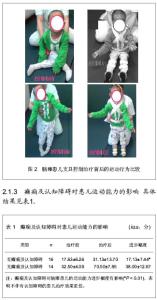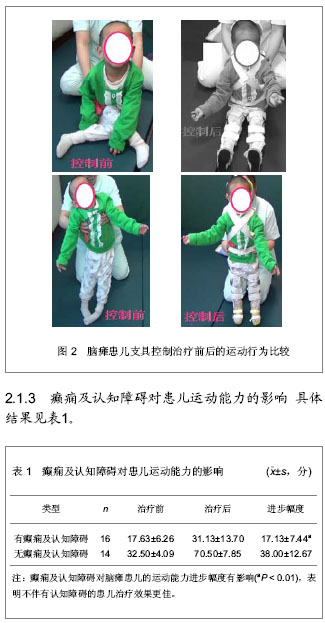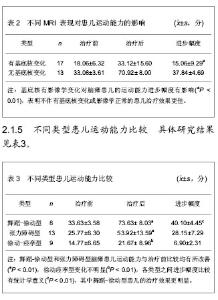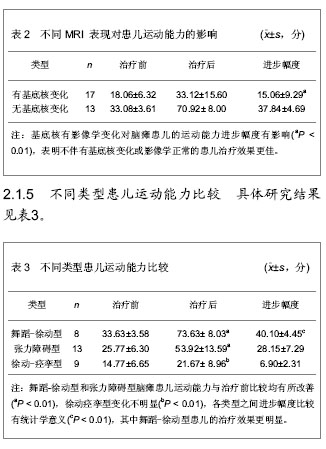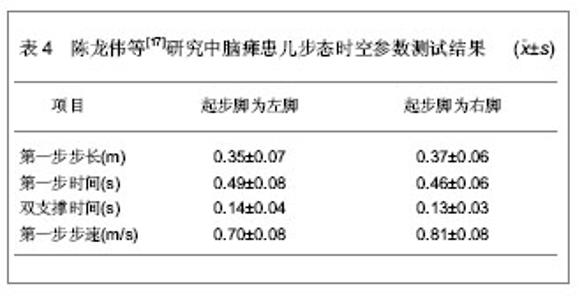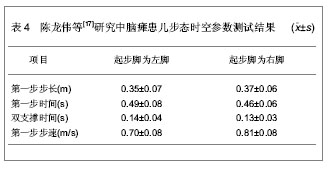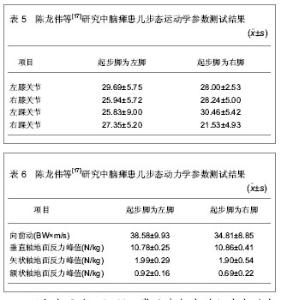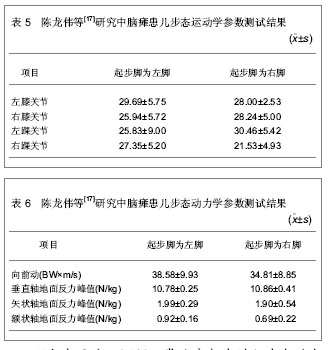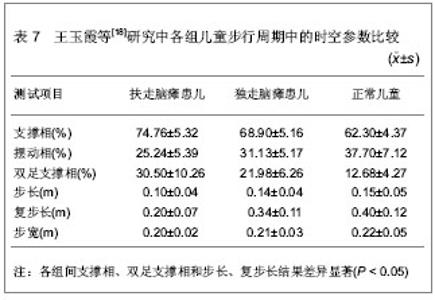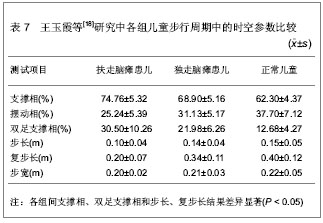| [1] Rosenbaum P, Paneth N, Leviton A, et al. A report: the definition and classification of cerebral palsy April 2006. Dev Med Child Neurol Suppl. 2007;109:8-14.
[2] 阎炯,刘念,张庆松.小儿脑性瘫痪病因学的研究进展[J].中国实用儿科杂志,2007,22(3):231-233.
[3] 江晓峰,胡雪艳.双侧痉挛型脑瘫患儿的步态特征分析[J].中国康复理论与实践,2009,15(1):65-66.
[4] 王志敏,陈龙伟,李树伟,等.痉挛性脑瘫患儿步态的运动学参数分析[J].陕西医学杂志,2010,39(2):140-142.
[5] Krasovsky T, Levin MF. Review: toward a better understanding of coordination in healthy and poststroke gait. Neurorehabil Neural Repair. 2010;24(3):213-224.
[6] Dejnabadi H, Jolles BM, Aminian K. A new approach for quantitative analysis of inter-joint coordination during gait. IEEE Trans Biomed Eng. 2008;55(2 Pt 1):755-764.
[7] 陈龙伟,王珏,石磊,等.痉挛型脑瘫患儿步态的膝-踝关节运动协调性的分析[J].西安交通大学学报(医学版),2011,32(4):508-511.
[8] Brown CR, Hillman SJ, Richardson AM, et al. Reliability and validity of the Visual Gait Assessment Scale for children with hemiplegic cerebral palsy when used by experienced and inexperienced observers. Gait Posture. 2008;27(4):648-652.
[9] Desloovere K, Molenaers G, Feys H, et al. Do dynamic and static clinical measurements correlate with gait analysis parameters in children with cerebral palsy? Gait Posture. 2006;24(3):302-313.
[10] DeLuca PA, Davis RB 3rd, Ounpuu S, et al. Alterations in surgical decision making in patients with cerebral palsy based on three-dimensional gait analysis. J Pediatr Orthop. 1997;17(5):608-614.
[11] Farmer SE, Pearce G, Stewart C. Developing a technique to measure intra-limb coordination in gait: applicable to children with cerebral palsy. Gait Posture. 2008;28(2):217-221.
[12] 孙嘉利,唐丹,钟世镇.三维步态分析的研究与应用[J].中国组织工程研究与临床康复,2007,11(5):944-948.
[13] Dobson F, Morris ME, Baker R, et al. Gait classification in children with cerebral palsy: a systematic review. Gait Posture. 2007;25(1):140-152.
[14] 史惟,杨红,施炳培,等.国内外脑性瘫痪定义、临床分型及功能分级新进展[J].中国康复理论与实践,2009,15(9):801-803.
[15] 陈秀洁,李树春.小儿脑性瘫痪的定义、分型和诊断条件[J].中华物理医学与康复杂志,2007,29(5):309.
[16] 中国知网.中国学术期刊总库[DB/OL].2013-5-26.https://www.cnki.net
[17] 陈龙伟,王珏,王志敏,等.痉挛性脑瘫患儿起步过程步态特征的生物力学分析[J].中国运动医学杂志,2009,28(6):644-64.
[18] 王玉霞,于涛,楮琴,等.三维步态分析痉挛性脑性瘫痪儿步行中时空参数和骨盆运动特征[J].中国组织工程研究,2012,16(22):4039-4043.
[19] 侯梅,范希文,于荣,等.不随意运动型脑瘫临床特点分析[J].中国康复理论与实践,2006,12(1):53-55.
[20] Yokochi K, Shimabukuro S, Kodama M, et al. Motor function of infants with athetoid cerebral palsy. Dev Med Child Neurol. 1993;35(10):909-916.
[21] 刘宏伟,陈娟,卢红梅.儿童不随意运动型脑性瘫痪34例临床分析[J].中国实用儿科杂志,2007,22(5):400.
[22] 陈景云,安鲁榕,陈文雄,等.手足徐动型脑性瘫痪43例临床特征分析[J].中国临床康复,2003,7(18):2617.
[23] 尤仲敏.综合康复治疗小儿脑瘫效果观察(附230例报告)[J].山东医药,2011,51(14):103-104.
[24] 窦建.家庭康复及支具在小儿脑瘫治疗中的应用[J].山东医药,2011,51(9):105.
[25] 徐开寿,麦坚凝,何璐,等.坐姿矫正系统对脑瘫患儿卧与坐位功能的影响[J].中国康复,2005,20(4):222-223.
[26] 吕智海,李晓捷,王立萍.脑性瘫痪的矫形器治疗进展[J].中国伤残医学,2008,16(6):132-134.
[27] 赵辉三.假肢与矫形器学[M].北京:华夏出版社,2006:140-143.
[28] Lin RS, Gage JR. The neurological control system for normal gait. J prosthet Orth, 1990;2(1):1-11.
[29] 李润洁.脑瘫患儿踝足矫形器配戴前后对运动功能的量化评价[J].中国康复,2003,18(3):177.
[30] 李晓捷.实用小儿脑性瘫痪康复治疗技术[M].北京:人民卫生出版社,2006:7-10.
[31] 孔勉,董小丽,曾敏,等.悬吊运动(SET)治疗脑瘫运动功能障碍疗效观察[J].按摩与康复医学,2011,2(36):14.
[32] Trueblood PR. Partial body weight treadmill training in persons with chronic stroke. NeuroRehabilitation. 2001;16(3):141-153.
[33] 漆带丽,张惠佳.减重步行训练在儿童脑瘫康复中的应用[J].中国康复理论与实践,2012,18(2):137-140.
[34] 陆冬梅.脑瘫患儿98例临床康复疗效分析[J].吉林医学,2011,32(32):6778-6779.
[35] 钱旭光,刘振寰.不随意运动型脑性瘫痪患儿不同亚型运动功能预后的回顾性分析[J].中国中西医结合儿科学,2010,2(1):18-20. |
